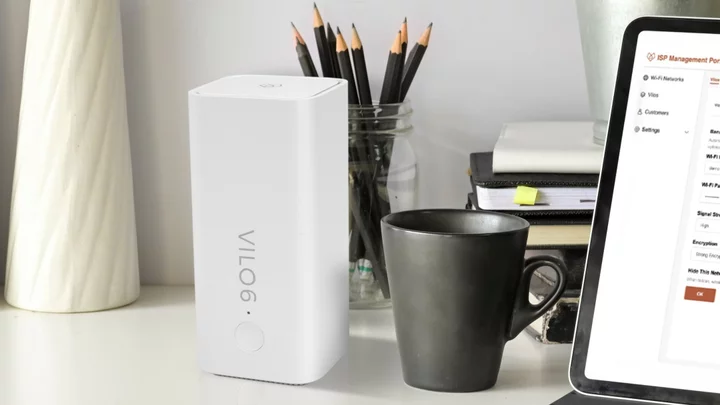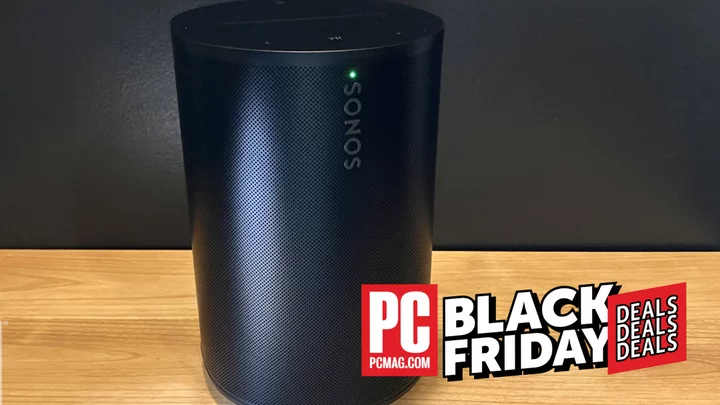When we reviewed the Vilo Mesh Wi-Fi System back in 2021, we were impressed with its affordability, ease of use, and free parental control software, but lamented its reliance on older 802.11ac (Wi-Fi 5) technology and its lackluster throughput performance. The new Vilo 6 Mesh Wi-Fi System ($154.99 for a 2-pack) is also reasonably priced, uses more current Wi-Fi 6 technology, and comes with free Bark parental controls. It lacks supports for a few key Wi-Fi 6 features, however, and its throughput performance is lacking. For around the same price, the Editors’ Choice-winning Eero 6+ offers much better throughput performance and pulls double duty as a home automation hub.
Think of It as 'Wi-Fi 6 Lite'
We tested the Vilo 6 Mesh System 2-Pack, which uses two identical nodes to cover homes of up to 4,000 square feet. For smaller areas such as apartments and dorm rooms, you can purchase a single node with 2,000 feet of coverage for $79.99. The 5.9-by-2.7-by-2.7-inch (HWD) nodes are nearly identical to the original nodes, but this time around the front sports a Vilo 6 badge. A pairing button adorns the front near the base, and above that is an LED indicator. The LED is solid white when the node is connected to the internet, burns solid red when starting up, flashes white when internet connectivity is intermittent, is solid amber when the node is ready to be configured, and flashes amber during the pairing process. A flashing red LED indicates no internet connectivity.
(Credit: Vilo)You don’t get any multi-gig WAN/LAN ports or USB ports with this system, but it is equipped with a 1GbE WAN port and two 1GbE LAN ports. They are located on the rear panel, where they are joined by a reset button and a power port. As with the Wi-Fi 5 version, the Vilo 6 supports wired Ethernet backhaul, but it is configured for wireless backhaul by default. You’ll have to delete the node and reset it to its factory settings to enable wired backhaul.
Each Vilo 6 node contains an 880MHz dual-core CPU, 256MB of RAM, and 16MB of flash memory. Also under the hood are four internal antennas and dual-band (2.4GHz and 5GHz) Wi-Fi radios. Although the Vilo 6 is a Wi-Fi 6 system, it doesn’t support a few key Wi-Fi 6 technologies, including orthogonal frequency-division multiple access (OFDMA) transmissions and 160MHz channels. However, it does support MU-MIMO data streaming, beamforming, and WPA3 encryption. As an AX1800 router, the Vilo 6 can hit maximum data rates of 600Mbps on the 2.4GHz band and 1,200Mbps on the 5GHz band.
The Vilo 6 uses the same mobile app as the original Wi-Fi 5 Vilo system, but the Vilo 6 offers more robust parental controls powered by Bark. You can create individual or whole-home profiles and use customizable age-appropriate filters to block access to adult content, social media sites, games, streaming services, and shopping sites. You can also configure Bark to activate screen time and location alerts, but this requires a paid subscription. Missing are network security tools that scan your network and device for viruses and other malware.
(Credit: Vilo)The mobile app opens to a My Networks screen with panels for any installed Vilo networks. Tap the Vilo 6 panel to open a screen with a large Dashboard button and separate panels labeled Vilos, Devices, Parental Controls, Guest Wi-Fi, Usage Reports, and Restart Wi-Fi. Swipe to the left for a network map and a signal strength indicator for any connected devices.
Tap the Dashboard button to launch a screen where you can enable or disable band steering, update firmware, access Wi-Fi settings (SSID, password, encryption type, transmit power), and reduce interference by optimizing Wi-Fi channel selection.
Tap the Vilos panel to view information for each node, such as how many and which clients are connected to it, the network connection strength, and the MAC and IP addresses. Here you can also enable or disable the LED indicator. The Devices panel takes you to a screen where you can view information about each connected client, such as how long it has been online, the connection type (2.4GHz, 5GHz, or wired), which node it is connected to, and its upload and download activity.
(Credit: Vilo)Tapping the Parental Controls panel provides access to the aforementioned Bark controls, while tapping the Guest Wi-Fi panel lets you create a guest network with a specific duration time. The Usage Report keeps track of daily, weekly, and monthly data usage for all nodes and clients, and the Restart Wi-Fi panel lets you manually restart the system or create a restart schedule.
Testing the Vilo 6 Mesh: Easy Installation
Setup is a snap. Start by downloading the Vilo mobile app and creating an account, then tap Add Vilo on the Home screen. Follow the instructions to unplug your modem for two minutes, then connect the Vilo router to your modem and power up both devices. When the LED turns solid amber, use your phone to scan the QR code on the base of the router node and tap Activate Network when prompted. Tap Next once the network is active, and change the SSID and password if you prefer (the default SSID and password are on the base). Tap Next and then tap Add Another Vilo to pair the satellite node with the router node. Select Add to Existing Network and then tap Next to automatically add the node to your new network. After a few seconds, the LED will turn white indicating that the node is up and running. If prompted, update the firmware to complete the installation.
While the Vilo 6 deserves high marks for its ease of setup, it did not fare very well on our throughput performance tests. The router node’s score of 524Mbps on the close-proximity test was significantly slower than the competition: The Motorola Q11 router scored 895Mbps, the Wyze Mesh router scored 914Mbps, and the Eero 6+ router scored 938Mbps. On the 30-foot test, the Vilo 6 router managed 260Mbps, compared with the Wyze Mesh router’s score of 322Mbps and the Motorola Q11’s score of 315Mbps. The Erro 6+ router beat them all with a score of 367Mbps.
Results were similar for the Vilo 6 satellite node. Its score of 285Mbps on the close proximity test lagged the Motorola Q11 node (441Mbps), the Wyze Mesh node (488Mbps), and the Eero 6+ node (538Mbps). At a distance of 30 feet, the Vilo 6 node garnered just 201Mbps, while the Motorola Q11 node scored 410Mbps and the Wyze Mesh node scored 412Mbps. The Eero 6+ node led the pack with a score of 508Mbps.
While the Vilo 6 struggled in our throughput tests, it showed good Wi-Fi signal range, which we measure using an Ekahau Sidekick diagnostic device and Ekahau’s Survey software. (Ekahau is owned by Ziff Davis, the publisher of PCMag.) The Survey software generates a colorful heat map depicting signal penetration throughout our test home, with dark green colors representing the strongest signals and yellow colors representing weaker signals. Gray colors indicate very weak or no measurable signal reception. The two white circles represent the location of the router and satellite nodes.
(Credit: Ekahau)As shown on the map, the Vilo 6 system had no trouble delivering a strong Wi-Fi signal throughout our test home.
Verdict: Simple and Affordable, But Not So Fast
The Vilo 6 Mesh Wi-Fi System offers an easy and affordable way to bring Wi-Fi 6 to every room in your home. It comes with free parental controls that’ll help prevent access to inappropriate websites, and it delivered good signal range in testing. However, its throughput performance was subpar. Additionally, this system doesn’t support OFDMA or 160MHz channels, both of which are key features of Wi-Fi 6.
As a result, the Vilo 6 will handle web surfing and other basic home networking tasks, but it is not the best choice for gaming, streaming high-resolution video, or downloading large files. For these types of tasks, we suggest our Editors’ Choice winner, the Eero 6+. You can pick up an Eero 6+ two-pack for the same price as the Vilo 6 and get much faster throughput, plus the ability to control home automation devices using the system’s built-in Thread and ZigBee circuitry.









